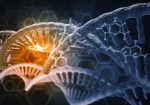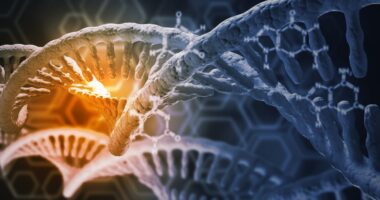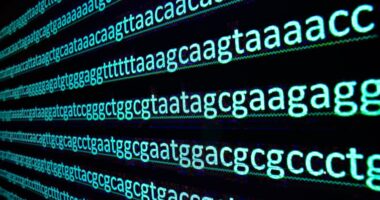HLA Gene Variants Linked to SSc Subtypes, Self-Reactive Antibodies

Variants of immune-regulating human leukocyte antigen (HLA) genes were associated with the risk of systemic scleroderma, subtypes of the condition, and the presence of self-reactive antibodies, a large-scale genetic analysis showed.
These findings underscored the genetic contribution to the disease and support future investigations into immunological susceptibility and external environmental stimuli that trigger autoimmunity in people with systemic scleroderma, the researchers noted.
The analysis, “Contribution of HLA and KIR Alleles to Systemic Sclerosis Susceptibility and Immunological and Clinical Disease Subtypes,” was published in Frontiers in Genetics.
Systemic scleroderma, also called systemic sclerosis (SSc), is a multisystem autoimmune disease marked by the accumulation of scar tissue in the skin and organs such as the heart, kidney, lungs, and digestive tract.
The two major subtypes of SSc include limited cutaneous SSc (lcSSc), wherein scarring is limited to the face, lower arms, hands, and fingers, with some organ involvement, and diffuse cutaneous SSc (dcSSc), a more severe form, which is associated with widespread skin involvement and internal organ damage.
Although SSc is not known as an inherited disease, those with the condition often have family members with another autoimmune disease, suggesting that autoimmune diseases such as SSc may have a genetic component.
Variations in genes that encode for HLAs, proteins that regulate immune responses, are associated with SSc. Different HLA variants linked to either lcSSc or dcSSc imply that genetic variability significantly underlies the clinical variability of SSc.
HLAs fall into different classes. Class II HLAs are found on the surface of immune cells and stimulate immune responses leading to the production of antibodies, while class I HLAs are located on the surface of all cells with a nucleus, which signal to the immune system that the cell is infected.
Class I HLA signals are recognized by killer immunoglobulin-like receptors (KIRs), proteins found on immune cells called natural killer (NK) and T-cells. As their names suggest, these cells target and kill infected body cells. KIRs work to regulate the activity of these killer cells depending on the signals presented by class I HLA proteins.
Researchers in the U.K. and Australia conducted a large-scale investigation into HLA and KIR inheritance in two independent, ethnically matched groups of SSc patients. This analysis included 1,465 SSc cases and 13,273 people without SSc as controls.
Consistent with previous reports in multiple ethnic groups, the class II HLA variant called HLA-DRB1*11:04 was associated with a 2.8-times increased risk of SSc, while the HLA-DPB1*13:01 variant was related to a 2.2-times increased risk. Of note, HLA-DP, HLA-DR, and HLA-DQ refer to class II HLA genes, while class I HLA genes include HLA-A, HLA-B, and HLA-C.
Protective associations were identified, linked to a nearly 50% reduction in SSc risk. These included the class II HLA variants HLA-DRB1*07:01, HLA-DQA1*02:01, HLA-DQB1*02:02, and HLA-DRB4*01:01. Two previously unknown class I HLA protective variants were also found: HLA-B*44:03 and HLA-C*16:01.
HLA associations were further examined in patients with either lcSSc or dcSSc. The class II disease-risk variant HLA-DPB1*13:01 was associated with a 3.2-times increased dcSSc risk and a 1.75-times increased risk for lcSSc. The other risk variant, HLA-DRB1*11:04, remained significant for both lcSSc (2.76-times increased risk) and dcSSc (2.93-times increased risk).
Protective associations were linked to class II variants HLA-DRB1*07:01, HLA-DQA1*02:01, HLA-DQB1*02:02, HLA-DRB4*01:01, as well as class I HLA-B*44:03 and HLA-C*16:01. These variants were more prominent in lcSSc, with a relative reduction in lcSSc risk under 55% compared to a more than 38% relative reduction in dcSSc risk.
The team then examined these variants in those who test positive for different types of anti-nuclear, self-reactive autoantibodies (ANA), which are detected in the bloodstream in up to 95% of SSc patients.
The class II HLA variants HLA-DQA1*01:01, DQB1*05:01, and DRB1*01:01 were seen at a significantly increased frequency in patients who test positive for anti-centromere antibodies (ACA), which are found in up to 30% of all SSc cases. These variants were found at a reduced frequency in those with anti-topoisomerase autoantibodies (ATA). In addition, disease risk associations were seen with HLA-DQA1*05:01 and DQB1*02:01 variants in patients with anti-nucleolar antibodies (ANoA).
The two independent class II SSc risk variants, HLA-DPB1*13:01 and HLA-DRB1*11:04, appeared to be driven almost exclusively by ATA-positive patients. These variants occurred at a significantly higher frequency than those who were ATA negative. The strongest protective class I HLA variants were seen in lcSSc relative to dcSSc.
Lastly, the team investigated links between class I HLA variants and KIR genes, which interact to active or suppress immune responses. On their own, none of the 14 KIR genes showed a significant association with SSc.
An interaction was found between the suppressing KIR3DL1 receptor and signals carried by the HLA-B*44:03 variant, which is protective for lcSSc. This interaction was epistatic, meaning the effect of the genetic variant depends on the presence or absence of variants in other genes.
Another interaction was observed between HLA-C1 signals and KIR2DL3, KIR2DL2, and KIR2DS2 genes, such that those with HLA-C1 carrying the immune-activating receptor KIR2DS2 were at an increased risk of SSc relative to KIR2DL3-positive individuals. The inhibitory receptor KIR2DL3 was seen at a higher frequency in HLA-C*16-positive controls (90.2%) than in HLA-C*16-positive SSc cases (79.7%).
“Here we report an extensive analysis of class I and II HLA associations with SSc, and clinical and serological subtypes of disease,” the researchers wrote. “The substantial size of our study cohort has enabled us to identify HLA associations … that differentiate autoantibody positive and negative SSc patients, emphasising the genetic [variability] underpinning this disease.”
“Furthermore, we identify two new HLA class l associations, and show that co-inheritance of HLA class I [signals] and KIRs … may further contribute to an individual’s underlying risk of developing SSc,” the researchers added. “Clear elucidation of genetic associations with disease risk and autoantibody positivity in SSc may aid in functional studies addressing the inflammatory triggers for disease.”







